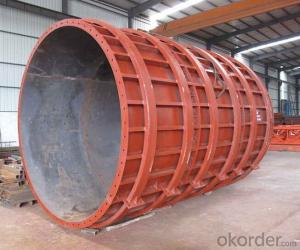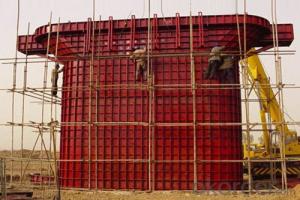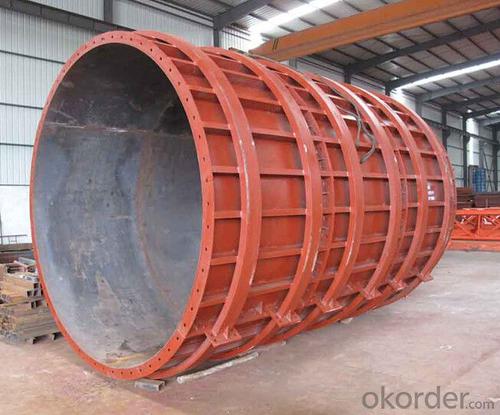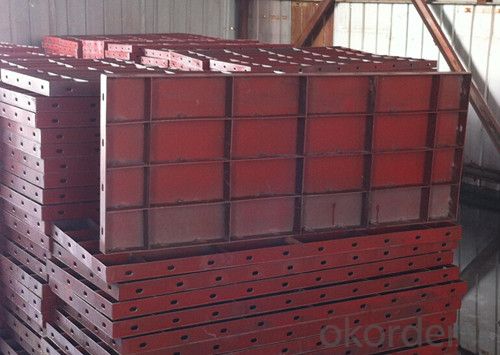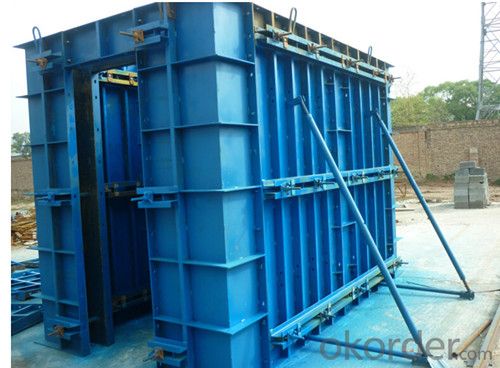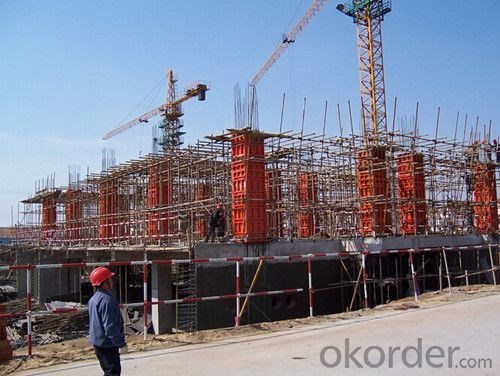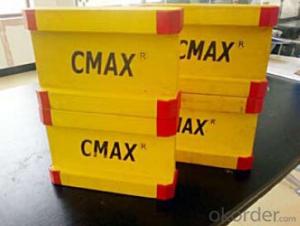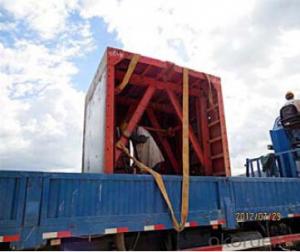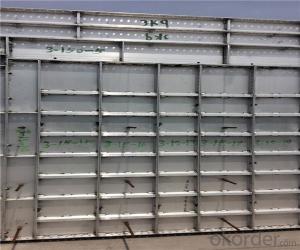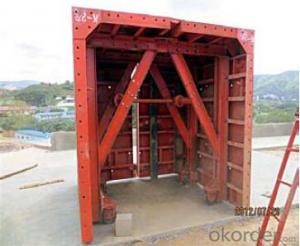Steel Formwork for Tunnel Building with thick Steel Plate
- Loading Port:
- Tianjin
- Payment Terms:
- TT OR LC
- Min Order Qty:
- 100 pc
- Supply Capability:
- 100000 pc/month
OKorder Service Pledge
OKorder Financial Service
You Might Also Like
Introduction for Steel Formwork :
Steel Formwork:used in highway,railway,bridge,tunnel and shearing wall,etc.Our company CNBM which is one of the largest State-Owned Enterprises in China which established in 1984 , has gained the confirmation from the specialist of China Architecture Scence Institute, and has been used by many building operation units and has been highly praised.In 2014, the total turnover volume of CNBM exceeds US$410 billion dollars with a total staff of 180,000. CNBM is listed in the World Top 500 Enterprises !
Characteristic for Wholly Steel Formwork :
1. High Smooth Surface
2. Convex ling for Edge Rib
3. Specialized Connection Pin for Edge Rib Connection
4. High Stiffness for Steel Surface
5. Light Weight for saving producing cost
6. Fast Separate and Easy transport
7. Recycling using
8. Scientific and Reasonable design to meet different working condition
Parameter and Specification :
Code | Size (mm) | Weight (KG) | Code | Size (mm) | Weight (KG) |
P12021 | 1200*2100*55 | 102.96 | P4018 | 400*1800*55 | 28.3 |
P12018 | 1200*1800*55 | 88.4 | P4015 | 400*1500*55 | 23.8 |
P12015 | 1200*1500*55 | 74.15 | P4012 | 400*1200*55 | 19.1 |
P12012 | 1200*1200*55 | 60.11 | P4009 | 400*900*55 | 14.6 |
P10018 | 1000*1800*55 | 76.01 | P4007 | 400*750*55 | 12.3 |
P10015 | 1000*1500*55 | 63.96 | P4006 | 400*600*55 | 9.95 |
P10012 | 1000*1200*55 | 60.11 | P3018 | 300*1800*55 | 20.7 |
P10009 | 1000*900*55 | 39.32 | P3015 | 300*1500*55 | 17.4 |
P9018 | 900*1800*55 | 70.89 | P3012 | 300*1200*55 | 14 |
P9015 | 900*1500*55 | 59.47 | P3009 | 300*900*55 | 10.7 |
P9012 | 900*1200*55 | 48.03 | P3007 | 300*750*55 | 8.8 |
P7518 | 750*1800*55 | 57.8 | P3006 | 300*600*55 | 7.3 |
P7515 | 750*1500*55 | 48.47 | P3004 | 300*400*55 | 5.46 |
P7512 | 750*1200*55 | 39.16 | P2515 | 250*1500*55 | 15.17 |
P7509 | 750*900*55 | 29.85 | P2512 | 250*1200*55 | 12.24 |
P7507 | 750*750*55 | 24.81 | P2509 | 250*900*55 | 9.32 |
P6018 | 600*1800*55 | 43.1 | P2507 | 250*750*55 | 7.71 |
P6015 | 600*1500*55 | 36.3 | P2506 | 250*600*55 | 6.39 |
P6012 | 600*1200*55 | 31.7 | P2015 | 200*1500*55 | 11.6 |
P6009 | 600*900*55 | 23.9 | P2012 | 200*1200*55 | 9.4 |
P6007 | 600*750*55 | 18.55 | P2009 | 200*900*55 | 7.1 |
P6006 | 600*600*55 | 16.25 | P2007 | 200*750*55 | 5.9 |
P5018 | 500*1800*55 | 36.27 | P2006 | 200*600*55 | 6.39 |
P5015 | 500*1500*55 | 30.15 | P2004 | 200*450*55 | 3.64 |
P5012 | 500*1200*55 | 25.55 | P1515 | 150*1500*55 | 9.5 |
P5009 | 500*900*55 | 20.38 | P1506 | 150*600*55 | 4 |
P5007 | 500*750*55 | 15.48 | P1504 | 150*450*55 | 2.98 |
P5006 | 500*600*55 | 13.58 | P1015 | 100*1500*55 | 7.5 |
Code | Size (mm) | Weight (KG) |
P1012 | 100*1200*55 | 6.9 |
P1009 | 100*900*55 | 4.6 |
P1007 | 100*750*55 | 3.8 |
P1006 | 100*600*55 | 3.1 |
P1004 | 100*450*55 | 2.33 |
E1515 | 150*150*1500 | 15.2 |
E1512 | 150*150*1200 | 12.26 |
E1509 | 150*150*900 | 9.34 |
E1507 | 150*150*750 | 7.77 |
E1506 | 150*150*600 | 6.46 |
E1504 | 150*150*450 | 4.87 |
E1015 | 100*150*1500 | 13.13 |
E1012 | 100*150*1200 | 10.61 |
E1009 | 100*150*900 | 8.07 |
E1006 | 100*150*600 | 5.44 |
Y1018 | 100*150*1800 | 14.56 |
Y1015 | 100*150*1500 | 12.29 |
Y1012 | 100*150*1200 | 9.72 |
Y1009 | 100*150*900 | 7.46 |
Y1007 | 100*150*700 | 6.19 |
Y1006 | 100*150*600 | 5.19 |
Y1004 | 100*150*450 | 3.92 |
J0018 | 50*50*1800 | 4.34 |
J0015 | 50*50*1500 | 3.7 |
J0012 | 50*50*1200 | 2.94 |
J0009 | 50*50*900 | 2.3 |
J0007 | 50*50*750 | 1.9 |
J0006 | 50*50*600 | 1.5 |
J0004 | 50*50*450 | 1.13 |
FAQ :
1. Who are we ?
We , CNBM , are a State-Owned Enterprise which established in 1984 , have 32 years experience ,enjoy high reputation .
2. Our Advantage :
Customized products , we have our own R&D department , we can design the drawing and suggest the suitable solution for your project .
3. Our after-Sales Service :
The international Sales Manager and Engineer can go to your job site for work direction and help you deal with your project .
Factory Photos :
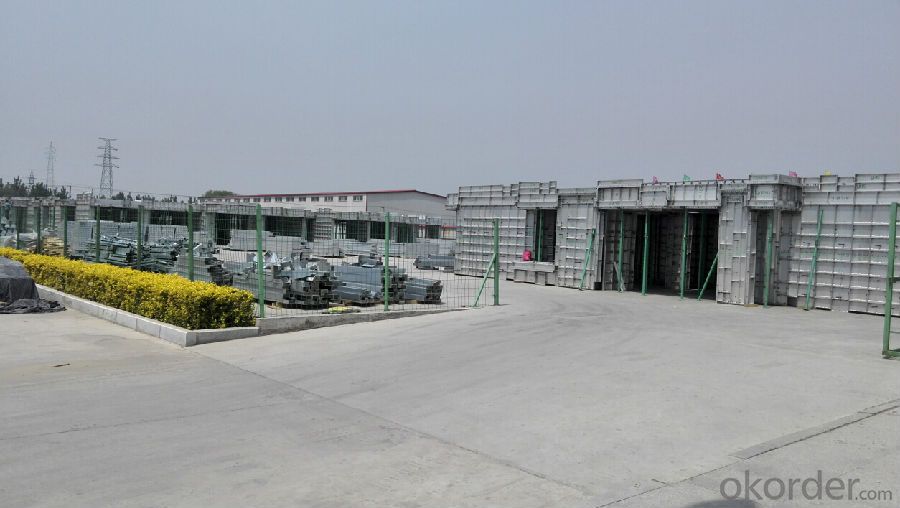
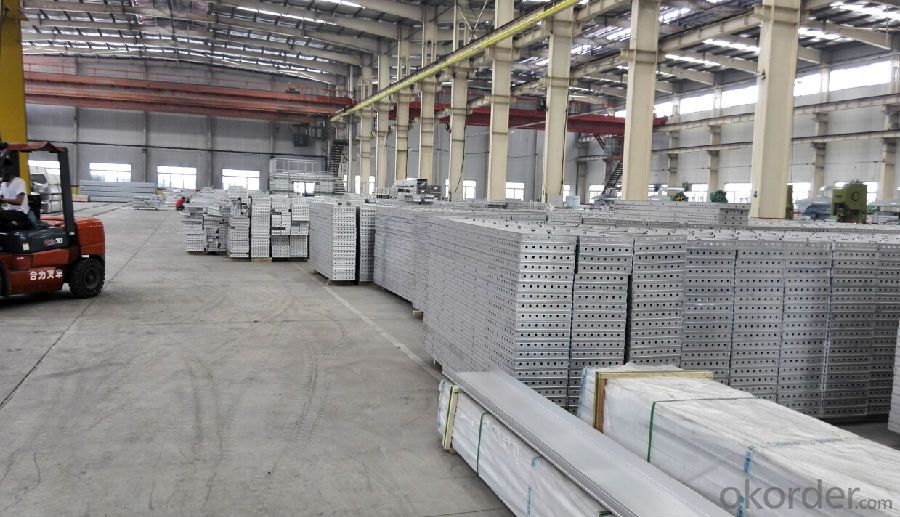
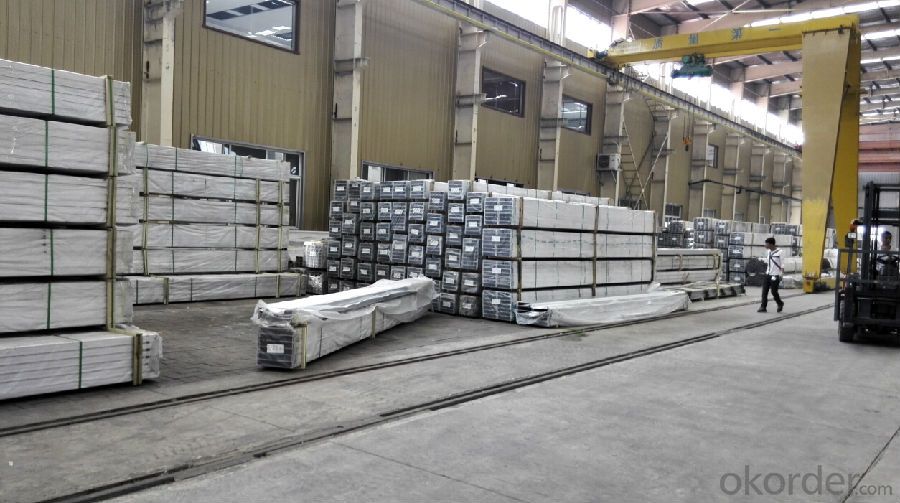
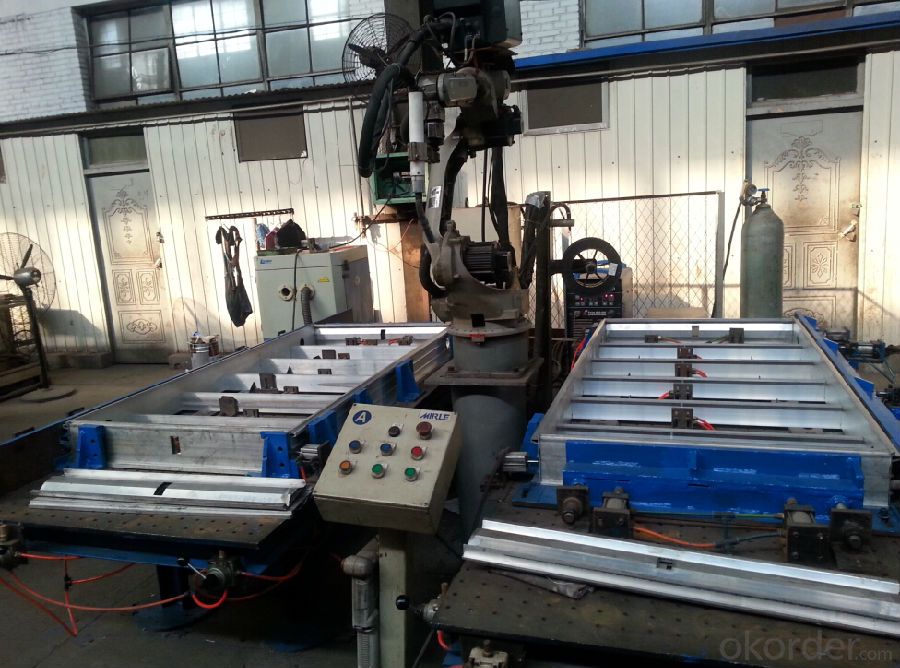
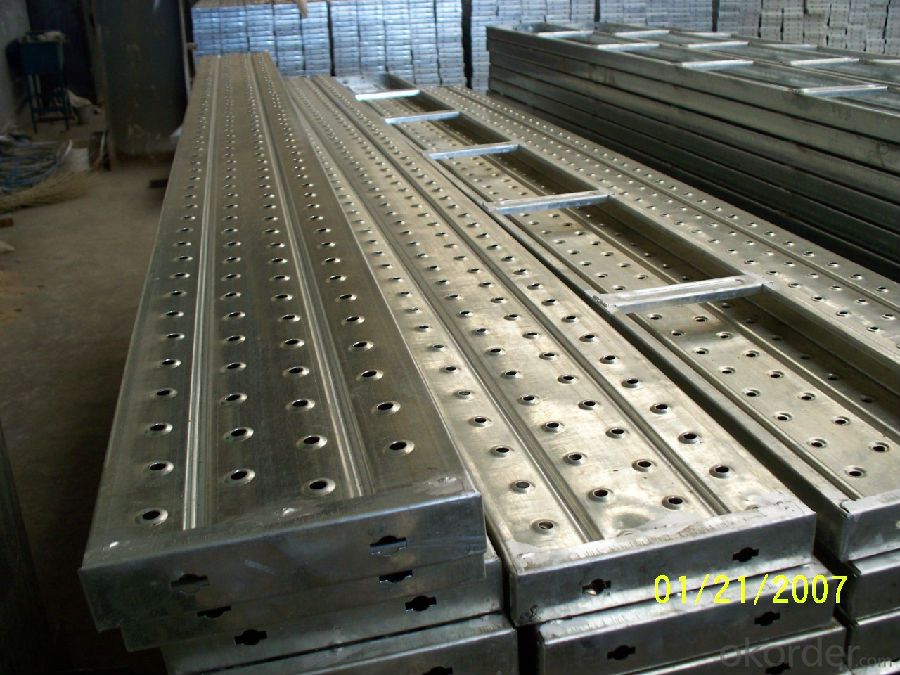
- Q: How does steel formwork affect the overall project timeline?
- Steel formwork can have a positive impact on the overall project timeline. Its durability and reusability allow for faster and more efficient construction processes, reducing the time required for formwork installation and removal. Additionally, steel formwork often requires less maintenance and repairs compared to traditional wooden formwork, minimizing potential delays caused by formwork issues.
- Q: How does steel formwork affect the overall sound insulation of the structure?
- Steel formwork does not directly affect the overall sound insulation of a structure. The purpose of steel formwork is to provide temporary support and shape to the concrete during the construction process. It is primarily used for concrete walls, slabs, columns, and beams. The sound insulation of a structure is mainly determined by the materials used for walls, floors, and ceilings, as well as the design and construction techniques employed. These factors contribute to the transmission of sound waves and the overall acoustic performance of the building. While steel formwork itself does not have inherent sound insulation properties, it can indirectly affect the sound insulation of a structure during the construction phase. If the formwork is not properly installed or secured, it may result in gaps or cracks in the concrete, which can compromise the sound insulation performance of the finished structure. However, it is important to note that any potential impact on the sound insulation of the structure due to steel formwork is temporary and can be rectified during the subsequent stages of construction, such as by using suitable acoustic insulation materials or soundproofing techniques. In summary, steel formwork does not directly affect the overall sound insulation of a structure. The sound insulation of a building is primarily determined by the materials and construction techniques used for walls, floors, and ceilings. Proper installation and subsequent measures can address any temporary impact on sound insulation caused by steel formwork during the construction process.
- Q: How does steel formwork handle concrete flowability and workability?
- Steel formwork is highly effective in handling concrete flowability and workability. Its smooth and rigid surface allows for easy movement and placement of concrete, ensuring a consistent and uniform flow during the pouring process. Additionally, steel formwork provides excellent support and stability, preventing any deformation or leakage of concrete. Its strength and durability enable it to withstand the pressure exerted by the concrete, ensuring that the formwork retains its shape and integrity throughout the entire curing period. Overall, steel formwork plays a crucial role in maintaining the desired flowability and workability of concrete, resulting in high-quality and structurally sound constructions.
- Q: What are the different types of steel formwork supports?
- Construction projects commonly employ various types of steel formwork supports. The following are some notable examples: 1. Adjustable Steel Props: Vertical supports that allow for height adjustment. They consist of steel tubes with an inner and outer tube that can be adjusted effortlessly. These props are often utilized to support horizontal formwork or scaffolding systems. 2. Soldier Formwork System: This type of support involves vertical steel members known as soldiers, which are evenly spaced along the formwork. The soldiers are engineered to withstand the lateral pressure exerted by wet concrete and provide support to the formwork panels. 3. Trench Struts: Trench struts are employed to stabilize and support formwork in trenches or excavations. They comprise steel tubes with adjustable length and are typically used alongside steel walers or beams to establish a robust framework for the formwork. 4. H-Frame Systems: Vertical formwork supports often rely on H-frame systems. These systems consist of interconnected steel frames shaped like an "H" to create a stable structure. They are frequently employed to support vertical formwork panels or serve as a framework for climbing formwork systems. 5. Steel Waler: A horizontal member utilized to support formwork panels. Steel channels or beams are commonly employed to construct walers. They are used in conjunction with vertical supports such as adjustable steel props or trench struts. These examples illustrate the variety of steel formwork supports widely employed in construction. The choice of support system depends on specific project requirements, including formwork design, load capacity, and desired adjustability.
- Q: How does steel formwork affect the overall construction waste generation?
- There are several ways in which steel formwork can significantly reduce construction waste. First and foremost, steel formwork is reusable, allowing it to be used multiple times for various projects. Unlike traditional timber formwork, which is often disposed of after a single use, steel formwork can be dismantled, transported, and reassembled for future construction projects. This greatly reduces the amount of waste generated from formwork materials. In addition, steel formwork is more durable and resistant to damage compared to other types of formwork. It can withstand greater pressure and is less likely to deform or break during the construction process. As a result, there is less need for frequent replacements and repairs. This further minimizes waste generation. Moreover, steel formwork enables precise and accurate construction, leading to less material wastage. Its rigid structure ensures that concrete is poured and cured in the desired shape and dimensions, eliminating the need for excessive concrete pouring or trimming. This reduces unnecessary material usage and decreases the amount of construction waste produced. Furthermore, cleaning and maintaining steel formwork is easier compared to other formwork materials. It can be cleaned and repaired more efficiently, reducing the chances of material degradation and the need for replacement. This not only prolongs the lifespan of the formwork but also reduces waste from discarded or damaged formwork materials. Overall, the use of steel formwork in construction projects has a positive impact on waste generation. Its reusability, durability, accuracy, and ease of maintenance contribute to minimizing construction waste, making it a more sustainable option for formwork in the construction industry.
- Q: How does steel formwork handle different concrete slump flow measurements?
- Steel formwork is highly durable and rigid, making it suitable for handling various concrete slump flow measurements. Its robust structure provides excellent support and stability, ensuring that the concrete maintains its desired shape and form during the pouring and curing process. Additionally, steel formwork can be easily adjusted and modified to accommodate different slump flow measurements, allowing for precise and efficient construction.
- Q: What are the considerations when designing steel formwork for slabs with openings?
- When designing steel formwork for slabs with openings, several important considerations need to be taken into account. These include: 1. Load-bearing capacity: The formwork must be able to support the weight of the concrete, as well as any additional loads that may be placed on it during construction or use. The formwork should be designed to withstand these loads without experiencing excessive deflection or failure. 2. Durability: Steel formwork should be designed to withstand the harsh conditions of construction sites, including exposure to moisture, chemicals, and physical impact. The material chosen should be resistant to corrosion and have a high strength-to-weight ratio. 3. Flexibility and adjustability: Since slabs with openings often have irregular shapes and sizes, the formwork should be designed to be flexible and adjustable. This allows for easy customization and ensures a precise fit for the openings. 4. Support for reinforcement: The formwork should provide adequate support for the reinforcement bars or mesh used within the slab. It should be designed to accommodate the placement and spacing of these reinforcements, ensuring proper concrete cover and structural integrity. 5. Ease of assembly and disassembly: The formwork system should be designed for easy assembly and disassembly, as it needs to be repeatedly used for multiple slabs with openings. The components should be lightweight and easily maneuverable, allowing for efficient construction and reduced labor costs. 6. Safety: Safety is of utmost importance in the design of steel formwork. The formwork should be designed to prevent accidents, such as slipping or collapsing, during assembly, concrete pouring, and removal. Adequate safety measures, such as guardrails and non-slip surfaces, should be incorporated into the design. 7. Cost-effectiveness: The design should aim to minimize material and labor costs while still ensuring the required strength and durability. Efficient use of materials and standardization of components can help reduce overall costs. 8. Compatibility with other construction systems: The formwork should be compatible with other construction systems, such as scaffolding or shoring, to ensure proper integration and coordination during the construction process. By considering these factors, designers can create steel formwork systems that are safe, durable, cost-effective, and efficient for slabs with openings.
- Q: How does steel formwork handle different concrete surface sealing products?
- Steel formwork is a widely used material in the construction industry for creating molds or structures to pour concrete into. When it comes to dealing with different sealing products for concrete surfaces, steel formwork offers certain advantages and considerations. First and foremost, steel formwork is exceptionally durable and strong, making it ideal for withstanding the application of various sealing products for concrete surfaces. These sealing products, like epoxy coatings, polyurethane sealers, or acrylic sealants, are typically designed to improve the durability, appearance, and resistance of the concrete surface. Steel formwork can handle the application process without sustaining any damage or compromise. Additionally, steel formwork provides a smooth and uniform surface for applying sealing products to concrete surfaces. This is crucial because a proper seal requires an even and consistent application to ensure optimal performance. With proper construction and maintenance, steel formwork can provide the necessary precision and flatness required for successful sealing product application. However, it is important to note that using specific sealing products for concrete surfaces may necessitate additional preparation and precautions when utilizing steel formwork. For example, if a sealing product requires a clean and porous surface to adhere properly, the steel formwork may need treatment or roughening to create the desired surface texture. Techniques like sandblasting or the application of a bonding agent can achieve this. Furthermore, before applying sealing products to concrete surfaces, it is crucial to ensure that the steel formwork is thoroughly cleaned and free from any residues or contaminants. Any remaining concrete, oils, or dirt on the formwork may interfere with the adhesion and performance of the sealing products. Regular maintenance and cleaning of the steel formwork are essential to guarantee its compatibility with various sealing products for concrete surfaces. In conclusion, steel formwork is a dependable and robust material that can handle different sealing products for concrete surfaces. Its durability, precision, and smooth surface make it a suitable choice for applying various sealing products. However, optimal compatibility and performance may require additional preparation, maintenance, and cleaning.
- Q: What are the considerations when selecting the appropriate formwork system for a project?
- When selecting the appropriate formwork system for a project, there are several considerations that need to be taken into account. These considerations include the type of structure being constructed, the required finish of the concrete, the project timeline, the budget, and the available resources. The type of structure being constructed is a crucial factor in selecting the formwork system. Different structures, such as walls, columns, or slabs, require different types of formwork systems to ensure proper support and stability. It is important to understand the specific requirements of the structure before choosing a formwork system. The required finish of the concrete also plays a role in selecting the appropriate formwork system. If a smooth and seamless finish is desired, a formwork system that can provide the necessary level of detail and precision must be chosen. On the other hand, if a rough finish is acceptable, a simpler and less expensive formwork system may be sufficient. The project timeline is another key consideration. Some formwork systems are quicker and easier to assemble and dismantle, which can help speed up the construction process. Additionally, the availability of the formwork system and the lead time required for procurement should also be considered to ensure that it aligns with the project schedule. Budget is always an important consideration in any construction project. Formwork systems vary in cost, and it is essential to select a system that fits within the project's budget. It is also important to consider the long-term cost implications, such as maintenance and reusability, to determine the overall cost-effectiveness of the chosen formwork system. Lastly, the available resources, including labor and equipment, should be taken into account when selecting a formwork system. Some systems may require specialized labor or equipment, which may not be readily available or may require additional costs. Considering the resources at hand will help determine the feasibility and practicality of a particular formwork system. In conclusion, selecting the appropriate formwork system for a project requires careful consideration of the type of structure, required concrete finish, project timeline, budget, and available resources. By evaluating these factors, project managers can make informed decisions that will contribute to the successful completion of the project.
- Q: How does steel formwork affect the overall productivity of the construction process?
- Steel formwork can significantly enhance the overall productivity of the construction process. Due to its durability and strength, steel formwork allows for faster assembly and disassembly, reducing the time required for each construction cycle. Its reusable nature also reduces the need for constant replacements, reducing both material and labor costs. Additionally, the precise and consistent dimensions of steel formwork ensure accurate and high-quality construction, minimizing errors and rework. Overall, steel formwork increases efficiency, reduces construction time, and enhances the productivity of the construction process.
Send your message to us
Steel Formwork for Tunnel Building with thick Steel Plate
- Loading Port:
- Tianjin
- Payment Terms:
- TT OR LC
- Min Order Qty:
- 100 pc
- Supply Capability:
- 100000 pc/month
OKorder Service Pledge
OKorder Financial Service
Similar products
Hot products
Hot Searches
Related keywords
